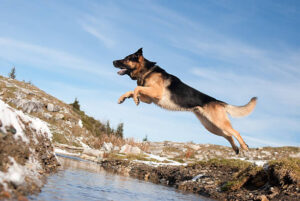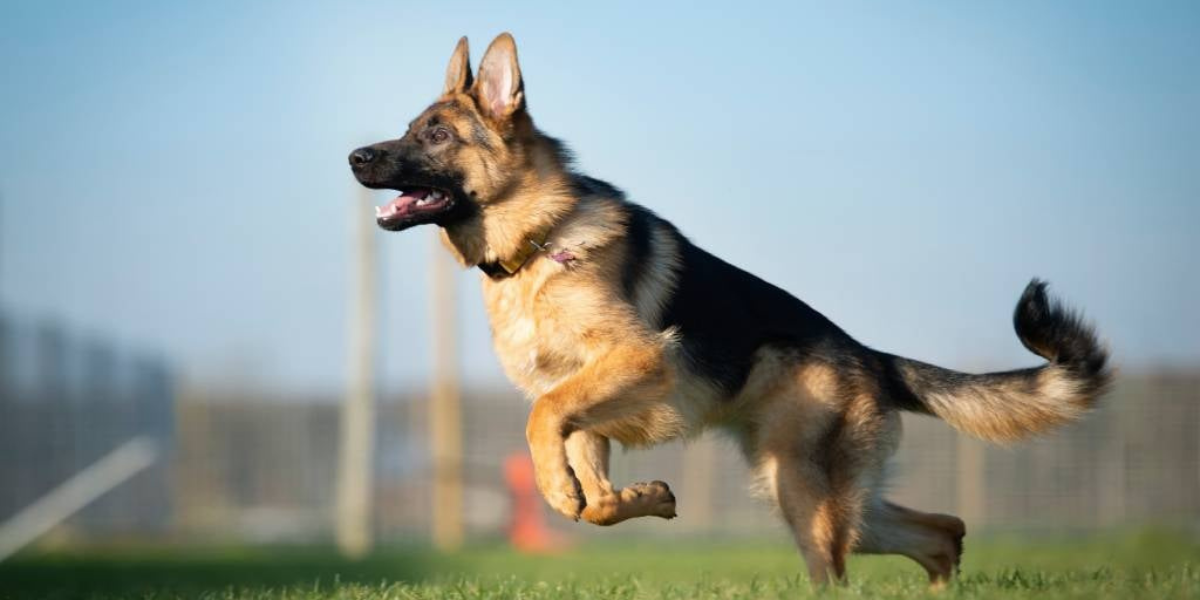German Shepherds are renowned for their strength, intelligence, and versatility, making them one of the most popular dog breeds globally. But one of the lesser-discussed yet equally impressive traits of the breed is its incredible jumping ability. Whether you’re a pet parent looking to understand your furry friend’s physical potential or a trainer preparing for agility competitions, this guide will break down everything you need to know about how high German Shepherds can jump.
How High Can a German Shepherd Jump?

Key Facts and Average Jump Heights
- Vertical Jump Height: On average, a healthy adult German Shepherd can jump up to 4 to 6 feet vertically.
- Running Jump Distance: When given a running start, some German Shepherds have been documented to jump as high as 8 feet.
- World Record: Though unofficial, some individual German Shepherds have cleared obstacles nearing 10 feet, especially in specialized police or military training scenarios.
These figures vary depending on the individual dog’s age, training, health, and physical condition.
Factors That Influence a German Shepherd’s Jumping Ability
Several elements impact how high a German Shepherd can jump:
1. Age
Puppies and Older Dogs:
Young German Shepherd puppies are still growing, so too much jumping can be harmful to their bones and joints. It’s best to let them develop slowly and avoid high-impact activities. Older dogs, on the other hand, might have issues like arthritis or joint pain that make jumping harder and even risky.
Best Age for Jumping:
German Shepherds are usually at their strongest and most athletic between 2 and 6 years old. During this time, they have the best mix of energy, strength, and coordination to jump safely and impressively.
2. Physical Fitness and Health
Dogs that get regular exercise and have strong, lean muscles are usually better at jumping. A fit German Shepherd will naturally have more power and energy to jump higher.
But it’s not just about muscle. Healthy joints—especially the hips and knees—are super important. German Shepherds can be prone to hip dysplasia, a condition that makes movement painful and can really lower their ability to jump. That’s why regular vet checkups and a healthy lifestyle matter so much.
3. Training and Socialization
German Shepherds that are trained for activities like agility courses, Schutzhund, or police work often become better and more confident jumpers. That’s because they learn to use their bodies in smart and controlled ways.
Using positive reinforcement—like treats, praise, or playtime—helps them feel good about jumping. Practicing jumps regularly in a safe way can improve both their skills and confidence over time.
4. Breed Lineage
Not all German Shepherds are the same when it comes to jumping. Working-line German Shepherds, which are bred for jobs like guarding, herding, or police work, usually have more strength, energy, and better jumping ability.
In contrast, show-line German Shepherds are mostly bred for looks and appearance in competitions. They might not be as physically built for high jumps as the working lines.
Why Do German Shepherds Jump?
Understanding the motivation behind a jump can help you manage or encourage it:
- Excitement or Greeting Behavior
- Escape Attempts (e.g., over fences)
- Training or Sports Participation
- Predatory Instinct or Chase Behavior
Common Questions About German Shepherds and Jumping
Can German Shepherds Jump Over Fences?
Yes. Many German Shepherds can clear a 6-foot fence with ease, especially if motivated by something on the other side.
Is Jumping Bad for My German Shepherd?
- The dog is too young or old.
- There are underlying joint or muscle issues.
- It’s done excessively without warm-ups or conditioning.
Can I Train My German Shepherd Not to Jump?
- Teach commands like “Off” or “Sit” as alternatives.
- Use rewards for calm greetings.
- Redirect excitement into fetching or agility.
Training Tips for Safe and Effective Jumping
1. Warm-Up and Stretching
Just like people, dogs need a good warm-up before doing any jumping or intense activity. A short walk or light play can help loosen their muscles and get their body ready to move. This helps prevent injuries and keeps their joints and muscles safe.
Adding some gentle stretching exercises—like slow leg movements or playful bowing—can also make a big difference in how well they perform and how safely they jump.
2. Start Small and Build Up
Don’t rush into big jumps right away. It’s best to start with low jumps and slowly increase the height as your German Shepherd gets stronger and more confident. This kind of progressive training helps them learn safely and reduces the risk of injury.
With time, patience, and regular practice, your dog will be jumping higher and feeling great about it!
3. Use the Right Equipment
Make sure to use safe and adjustable jump equipment when training your German Shepherd. Things like agility hurdles or soft jump bars are perfect because you can change the height as your dog improves.
Avoid using hard or unstable objects, as they can cause injuries. Good gear keeps your dog safe and helps build skills the right way.
4. Rest and Recovery Matter
Just like people, dogs need rest days between training sessions. Giving your German Shepherd time to recover helps prevent tiredness and injuries from overtraining.
Muscles grow and get stronger during rest, not just during exercise. So be sure to balance training with plenty of downtime to keep your dog healthy, happy, and ready to jump again.
German Shepherds in Agility and Sport
German Shepherds are top competitors in agility, Schutzhund, IPO, and obedience sports due to their mental focus and athleticism. Their ability to jump is crucial in these activities, making them standout performers when trained properly.
Safety Considerations
- Fence Height: If you’re a German Shepherd owner, your backyard fence should ideally be 7 feet or taller.
- Supervised Play: Don’t leave your dog unsupervised in areas where jumping could lead to escape or injury.
- Vet Check-Ups: Regular veterinary visits can ensure your dog is fit to jump and participate in agility sports.
Real-World Examples
- Police and Military Dogs: Trained German Shepherds often scale high walls and obstacles during operations.
- Agility Competitions: Many champion agility dogs are German Shepherds, regularly clearing complex jumps with ease.
Conclusion
So, how high can German Shepherds jump? While the average vertical leap is around 4–6 feet, some well-trained, athletic German Shepherds can jump up to 8 feet or more. Whether you’re training for sport or simply curious, understanding their leaping limits helps you provide a safer and more enriching environment.
With proper training, health monitoring, and fencing, you can keep your German Shepherd safe while allowing them to enjoy and develop their natural jumping talents.

